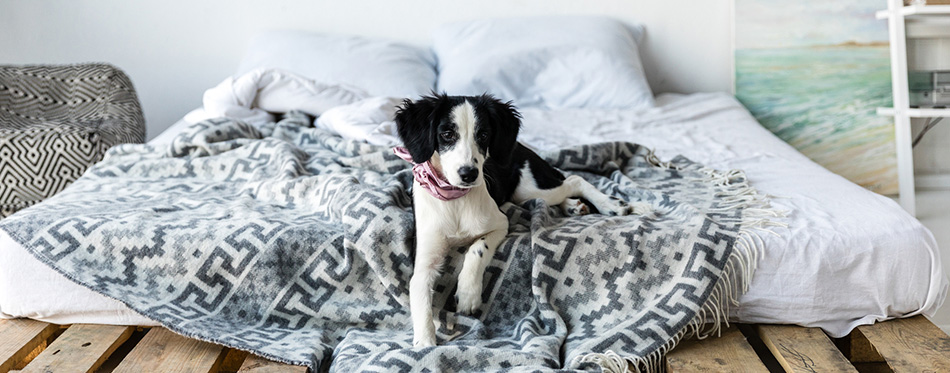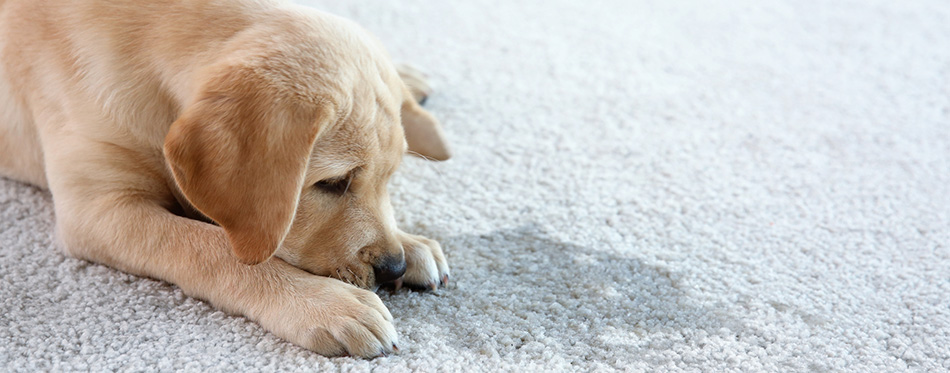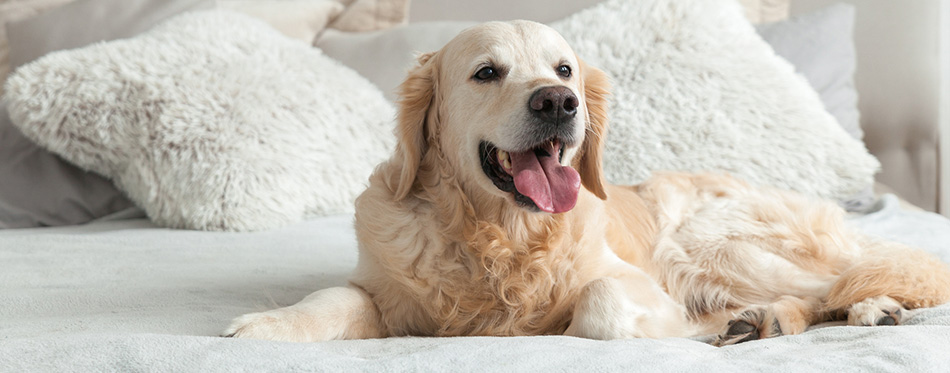If you had a child who always peed on his bed despite the fact that he is already well beyond the age of poor bladder control, then you already have an idea as to why dogs pee on beds. Unfortunately, bedwetting in dogs is a more complex issue than what our kids have to go through. So, if ever you find yourself asking “my dog peed on my bed what does that mean?” then you’ve come to the right resource. We will provide you with the most likely scenarios as to why such a behavior occurs in our beloved pets.

Dog Bedwetting: The Why
As we already pointed out, your dog peeing on your bed is a rather complex issue that is not necessarily only related to poor potty training in your hound. It can also be a sign of a medical problem that needs further evaluation so that the correct treatment can be provided. Let’s look at some of the possible reasons why Fido may pee on your bed.
Hormone-Responsive Urinary Incontinence
If you have a female dog that has already been spayed and that it has also been properly trained, one of the most often overlooked reasons why such a dog may pee on the bed is a condition called hormone-responsive urinary incontinence. The dog in this case is not really intentionally urinating on your bed. Instead, it lies down on the bed and urine leaks out from its urethra, soiling the bedding.
In incontinence, the muscles surrounding the tube where urine passes do not contract completely such that they don’t form a tight seal on the opening. Since there is a small space where urine can pass through, urine leaks outside without the dog knowing it.
Hormone-responsive urinary incontinence is clearly not a behavioral issue, but more the result of a procedure that is very common in the veterinary world – spaying. When a dog is spayed, the ovaries of the dog are surgically removed. But since the ovaries also produce a number of hormones especially estrogen, you can expect that the removal of the ovaries can also lead to a reduction in the levels of estrogen in the dog’s body. It is believed that estrogen plays a role in the tonicity of the muscles surrounding the urethra. Since there is less estrogen, the sphincter muscles do not clamp down on the urethra such that urine leaks out. In that sense, it is similar to older dogs that have substantially weakened urinary sphincter muscles.
Check out our guides on Dog Beds and Dog Pee Pads.
Urinary Tract Infections
A dog that pees on the bed should always be suspected of having urinary tract infection if it has been properly potty trained and that this behavior became evident only recently. It is imperative that other manifestations of urinary tract infections be correlated with the incidence of bed peeing to help rule out other potential causes of such a behavior. Dogs with urinary tract infections are typically weak or lethargic, may have fever, or even continuously lick their genitals in an attempt to ‘soothe’ the irritation.
Just like in humans, female dogs are more prone to urinary tract infections because of the relatively shorter urethra compared to male dogs. The proximity of the urethral opening to the anus just above the vulva also makes it more prone to bacterial invasion when the dog poops and liquid coming from the anus oozes out towards the vulva. Sitting on dirty surfaces can also introduce germs into the female dog’s vulva.
Infection of the urinary tract can cause irritation in the tissues of the urethra. This stimulates stretch receptors in the bladder which triggers the release of urine. Unfortunately, this is not the only issue that your dog will have. There can also be pain and itching. And the dog’s tendency to lick its genitals can also further aggravate the infection.
Diabetes
Diabetic dogs always come with the 3 Ps of the health condition: polyuria, polydipsia, and polyphagia which are the same in diabetic folks. These refer to an increase in urination, thirst, and hunger, respectively. Obviously, you will need to be extra careful when it comes to ascertaining the diabetic status of your pet.
The increase in urination seen in diabetes is related to an abnormally high level of glucose in the blood. In a process known as osmotic diuresis, the kidneys will attempt to remove this excess glucose by flushing it out in the urine. Sadly, water is also drawn out together with the glucose. This increases both the frequency and volume of urine. For more options, check out our detailed review of the best glucose monitors for dogs.

Old Age
Just like hormone-responsive urinary incontinence, older dogs may no longer be able to hold back their urine regardless of how much they try. The problem here is that as the dog ages, the muscle tone of the sphincters surrounding the urethra and that in the bladder is no longer as strong as it was during the dog’s younger days. So, urine leaks out.
The above-mentioned reasons are purely health- or medical-related and as such should be thoroughly evaluated by your veterinarian. If you don’t see any other signs or symptoms that may accompany the bed peeing incident of your dog, then you are most likely dealing with a behavioral issue.
Submissive Behavior
You may laugh, but it is now believed that overly submissive dogs are more prone to peeing in places where they shouldn’t. You cannot blame them because this is their way of ‘submitting’ to your ministrations; or this is what many folks want to believe. No one knows exactly how it works, but the point is that it is a general observation that overly submissive dogs tend to have this issue more often than those that are not so-called submissive.
The key here is ‘overly submissive’ which can mean heightened stress or anxiety. Highly excited or even frightened dogs are also known to exhibit the behavior. It is for this reason that owners of these dogs should be careful not to scold the pet as this can only worsen the conduct.
Marking Territory
Try to observe your dog if it goes around the house and pees everywhere but only in scant amounts. If it does, then you’re looking at a territorial behavior. Peeing in places puts a ‘mark’ on those places as the dog’s ‘territory’. So when it pees on the bed, it is also ‘marking’ it as part of its territory. Do understand that this behavior is most evident as your dog reaches the ‘adolescent’ stage. If you think this is an exclusively ‘male’ thing, you’d be surprised to know that female dogs have also been known to ‘mark’ their territories. Of course, this is debatable.
Incidentally, there is another reason why dogs ‘pee’ in scant amounts in even the most unlikely of places. It is believed that dogs are leaving behind their ‘calling cards’ to potential mates. If other dogs are able to sniff this scent they will know who to ‘call’.
Hiding Their ‘Scent’
This is something that is quite unbelievable, yet it is one of those explanations that are very plausible. In the wild, dogs have to hide their scent from predators. As such, they will try to cover their scent by ‘mixing’ it into the scent of their pack-mates. Have you ever noticed your dog peeing on the same spot as another dog from the same household? It’s a peculiar behavior, but one that makes sense.
When your dog pees on your bed, it can mean that it is trying to hide its scent with your own scent. They know that your scent on the bed will mask their own scent, making them feel less vulnerable to predators. You can always dispute this, why not? But if you see your dog also chewing on your dirty socks or even underwear, there’s a good chance that this line of reasoning is valid.
Poor Potty Training
It is fairly obvious that an improperly-trained hound can lead to it peeing on the bed. This is why it is imperative that puppies be potty-trained as early as 8 weeks in their lives. This will help address such issues in the future.
Related Post: Indoor Dog Potty

What You Can Do
If your dog pees in bed, the first thing you should do is to bring it to the vet so that the possible medical reasons for such a behavior can be ruled out. If your dog has hormone-responsive urinary incontinence, it may be placed on estrogen therapy or be given phenylpropanolamine. If there’s infection, then the appropriate antibiotics can be given while also providing for symptomatic care. If it’s diabetes, then control of blood sugar through sensible feeding may be necessary. If the issue is related to old age, then phenylpropanolamine may work.
Once these medical conditions have been ruled out, then you’re left with behavioral issues to contend with. Training your dog can go a long way towards addressing many behavior-related issues. As for territorial marking, neutering or spaying may be necessary; although we know spaying may trigger hormone-responsive urinary incontinence. The point is if you’re able to isolate the cause of the problem, then you can easily direct your attention to the cause.
Dogs pee on beds for a number of reasons. It can be because of a health problem or purely a behavioral one where anxiety may be an important factor.
Source:
- Dog Pees On Bed – AKC

